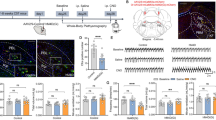Abstract
The anterograde amnestic effects of non-competitive NMDA antagonists MK-801 and HA-966 on classic fear conditioning in goldfish (Carassius auratus) were examined in a series of experiments. Experiments 1 and 2 contrasted the anterograde amnestic effects of MK-801, (+)HA-966, and (−)HA-966. Experiment 3 examined the effects of MK-801 and (+)HA-966 on the expression of conditioned responses. Experiments 4 and 5 investigated whether the potency of MK-801, (+)HA-966 or (−)HA-966 in blocking NMDA-induced convulsions paralleled their potency in producing amnesia. The results showed that MK-801 was more potent than (+)HA-966 in producing anterograde amnesia and impairing expression, while (−)HA-966 did not produce anterograde amnesia. The anticonvulsant potency of MK-801, (+)HA-966, and (−)HA-966 paralleled their amnestic potency. These findings suggested that MK-801 and (+)HA-966 produced anterograde amnesia by their specific antagonism of the NMDA receptor complex.
Similar content being viewed by others
References
Agranoff BW, Klinger PD (1964) Puromycin effect on memory fixation in the goldfish. Science 146:952–953
Benvenga MJ, Spaulding TC (1988) Amnestic effect of the novel anticonvulsant MK-801. Pharmacol Biochem Behav 30:205–207
Cotman CW, Iversen LL (1987) Excitatory amino acids in the brainfocus on NMDA receptors. Trends Neurosci 10:263–265
Danysz W, Wroblewski JT, Costa Z (1988) Learning impairment in rats byN-methyl-d-aspartate receptor antagonists. Neuropharmacology 27:653–656
Davies J, Watkins JC (1972) Is 1-hydroxy-3-amino-pyrrolidone-2 a selective excitatory amino acid antagonist? Nature New Biol 238:61–63
Evans RJ, Francis AA, Watkins JC (1978) Mg2+-like selective antagonism of excitatory amino acid-induced responses by alpha, epsilo-diaminopimelic acid,d-alpha-aminoadipate and HA-966 in isolated spinal cord of frog and immature rat. Brain Res 148:526–542
Fletcher EJ, Lodge D (1988) Glycine reverse antagonism ofN-methyl-d-aspartate (NMDA) by 1-hydroxy-3-amino-pyrrolidone-2 (HA-966) but not byd-2-amino-5-phosphonovalerate (D-AP5) on rat cortical slices. Eur J Pharmacol 151:161–162
Foster AC, Kemp JA (1989) HA-966 antagonizesN-methyl-d-aspartate receptors through a selective interaction with the glycine modulatory site. J Neurosci 9:2191–2196
Heale N, Harley C (1990) MK-801 and AP5 impair acquisition, but not retention, of the Morris Milk Maze. Pharmacol Biochem Behav 36:145–149
Kim JJ, DeCola JP, Landeira-Fernandez J, Fanselow MS (1991)N-Methyl-d-aspartate receptor antagonist APV blocks acquisition but not expression of fear conditioning. Behav Neurosci 105:126–133
Koek W, Colpaert FC (1990) Selective blockade of NMDA-induced convulsions by NMDA antagonists and putative glycine antagonists: relationship with phencyclidine-like behavioral effect. J Pharmacol Exp Ther 252:349–357
Miserendino MJP, Sananes CB, Melia KR, Davis M (1990) Blocking of acquisition but not expression of conditioned fear-potentiated startle by NMDA antagonists in the amygdala. Nature 345:716–718
Monaghan DT, Bridges RJ, Cotman CW (1989) The excitatory amino acid receptors: Their classes, pharmacology, and distinct properties in the function of the central nervous system. Annu Rev Pharmacol Toxicol 29:365–402
Morris RGM, Anderson E, Lynch GS, Baudry M (1986) Selective impairment of learning and blockade of long-term potentiation by anN-methyl-d-aspartate receptor antagonist, AP5. Nature 319:774–776
Morris RGM, Davis S, Butcher SP (1990) Hippocampal synaptic plasticity and NMDA receptors: a role information storage? Philos Transa R Soc Lond B 329:187–204
Parada-Turska J, Turski WA (1990) Excitatory amino acid antagonists and memory effects of drugs acting atN-methyl-d-aspartate receptors in learning and memory tasks. Neuropharmacology 29[12]:111–116
Sanger DJ, Joly D (1991) Effects of NMDA receptor antagonists andsigma ligands on the acquisition of conditioned fear in mice. Psychopharmacology 104:27–34
Schlumpf BE, Davis RE (1985) Vision in goldfish following bilateral tectal ablation. Behav Brain Res 18:193–199
Shapiro M, Caramanos Z (1990) NMDA antagonist MK-801 impairs acquisition but not performance of spatial working and reference memory. Psychobiology 18:231–243
Singh L, Donald AE, Foster AC, Huston PH, Iversen LL, Iversen SD, Kemp JA, Leeson PD, Marshall GR, Vass GA, Williams BJ (1990) Enantiomers of HA-966 (3-amino-1-hydroxypyrrolid-2-one) exhibit distinct central nervous system effects: (+)HA-966 is a selective glycine/N-methyl-d-aspartate receptor antagonist, but (−)HA-966 is a potent γ-butyrolactone-like sedative. Proc Natl Acad Sci USA 87:347–351
Staubli U, Thibault O, DiLorenzo M, Lynch G (1989) Antagonism of NMDA receptors impairs acquisition but not retention of olfactory memory. Behavioral Neuroscience 103[1]:54–60
Tallarida RJ, Murray RB (1987) Manual of pharmacologic calculations with computer programs, 2nd edn. Springer, New York
Turski L, Meldrum BS, Collins JF (1985) Anticonvulsant action of beta-kainic acid in mice: is beta-kainic acid anN-methyl-d-aspartate antagonist? Brain Res 336:162–166
Ward L, Masom SE, Abraham WC (1990) Effects of the NMDA antagonists CPP and MK-801 on radial arm maze performance in rats. Pharmacol Biochem Behav 35:785–790
Whishaw IQ, Auer RN (1989) Immediate and long-lasting effects of MK-801 on motor activity, spatial navigation in a swimming pool and EEG in the rat. Psychopharmacology 98:500–507
Wong EHF, Kemp JA, Priestley T, Knight AR, Woodruff GN, Iversen LL (1986) The anticonvulsant MK-801 is a potentN-methyl-d-aspartate antagonist. Proc Natl Acad Sci USA 83:7104–7108
Wong EHF, Knight AR, Woodruff GN (1988) [3H]MK-801 labels a site on theN-methyl-d-aspartate receptor channel complex in rat brain membranes. J Neurochem 50:274
Xu X, Davis RE (1992)N-Methyl-d-aspartate receptor antagonist MK-801 impairs learning but not memory fixation or expression of classical fear conditioning in goldfish (Carassius auratus) Behav Neurosci 106[2]:307–314
Author information
Authors and Affiliations
Rights and permissions
About this article
Cite this article
Xu, X., Klinger, P. & Davis, R. Comparative anterograde amnestic and anticonvulsant effects of two types of NMDA receptor antagonists: MK-801 and HA-966. Psychopharmacology 117, 333–339 (1995). https://doi.org/10.1007/BF02246108
Received:
Revised:
Issue Date:
DOI: https://doi.org/10.1007/BF02246108




